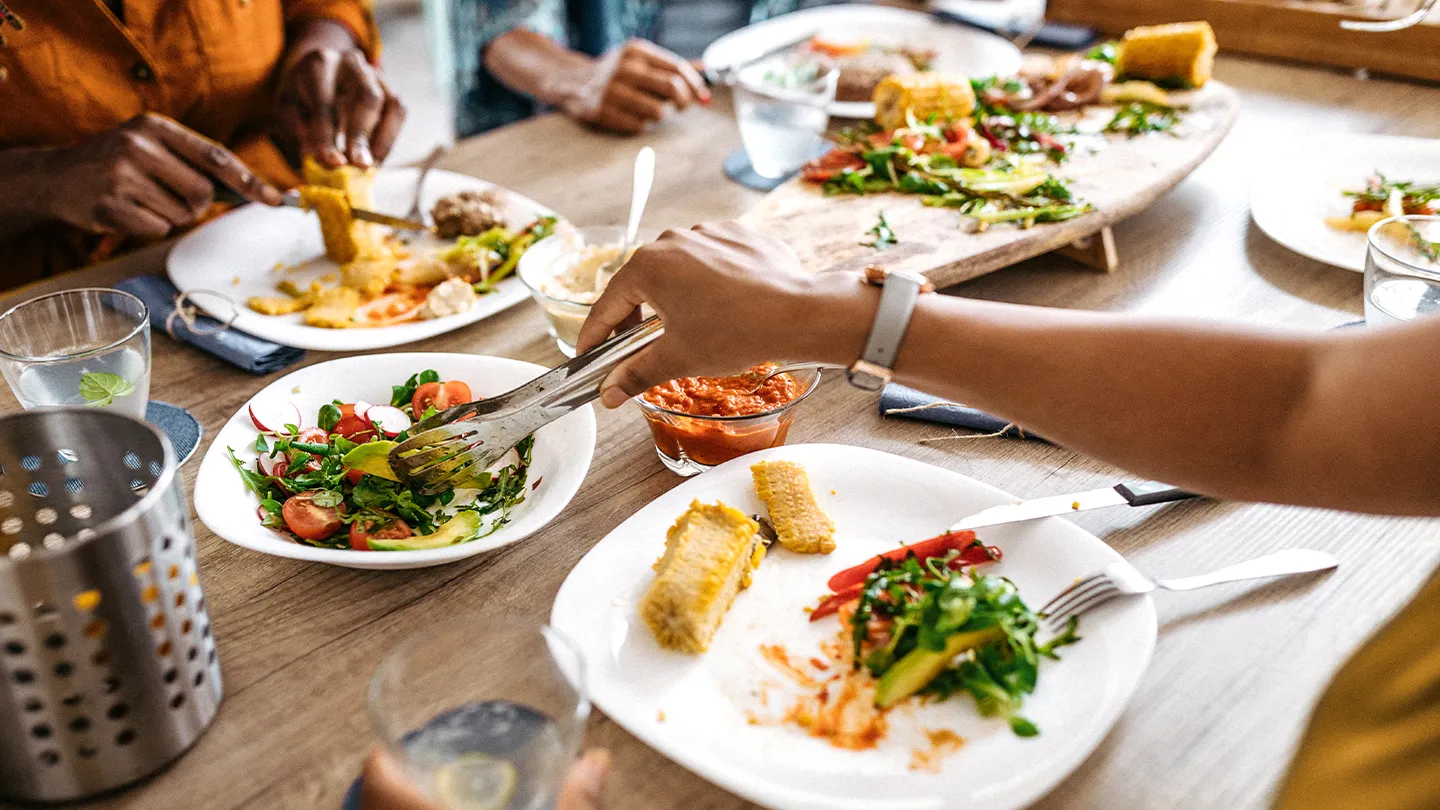Raise your hand if you ever find yourself saying, “Ugh, I’m full” … right before getting up for seconds or digging into dessert.
Yup. We’re right there with you.
Many of us overeat without knowing why, which means that learning to recognize fullness is important, says Melissa Rifkin, RD, of Melissa Rifkin Nutrition. “We’re not tuning into our bodies and feeling comfortable with satiety, namely because we don’t know what that is, and this can make it more likely we’ll gain weight,” she explains.
So what does fullness feel like, and why can it be so hard to recognize? Below, we ask two experts to weigh in on these questions — and share what we can do about it.
Why It’s Hard to Tell if You’re Full
There are many reasons for unintentional overeating. Maybe you grew up with adults who asked — or required — you to eat beyond your fullness to clean your plate, notes Rifkin. Or you may use food to help you get through stress, sadness, or loneliness when you’re actually seeking a type of “emotional fullness,” she says. Looking at screens while you eat can also distract you from feelings of fullness, adds Courtney Smith, RDN, CDCES, founder of The Keys to Nutrition.
In addition, your relationship to fullness may change physically. For example, recent research found that people who are categorized as obese may develop faulty brain responses to nutritional signals, prompting them to continue to eat past fullness.
On the other side of the coin, weight loss medications such as GLP-1 (glucagon-like peptide-1) receptor agonists reduce appetite and increase satiety. As a result, you may not eat enough or perhaps skip meals altogether because you already feel full, says Smith. It’s important to understand this new relationship with hunger so that you continue to eat regular, balanced meals and get the nutrients your body needs.
6 Ways to Know When You’re Full
Even if you’re disconnected from your fullness cues, you can learn how to determine when you’re full. Here are some ways to do it.
1. Check in With Your Hunger
Pause before, during, and after a meal to check in with your hunger using the hunger scale, recommends Smith. Rank your hunger from 1 (nearly empty) to 10 (stuffed). This can help you evaluate your physical hunger to determine if you’re ready to eat now, and how much to eat. Fullness would rank at about 6 or 7, meaning you’re satisfied but not uncomfortable.
2. Slow Down
Eating quickly has been shown to be associated with a 54 percent higher risk of metabolic syndrome and central obesity, as well as higher blood pressure, according to one meta-analysis. When you eat fast, it’s easier to overeat because you’re disconnected from your hunger-fullness cues. Putting your fork down between bites and focusing on chewing your food fully can help you slow down your eating rate, as well as truly taste and enjoy your food more.
You should also take an ample break before going back for a second helping. So how long after eating does it take to feel full? It takes 20 minutes for your stomach to communicate with your brain that you’re full, says Rifkin. “Wait that long [before] you get seconds. If you’re still hungry, go back for protein, which takes longer to digest and is filling, and vegetables, which are packed with fiber and water to also help you feel full,” she says.
3. Eat Regularly
If you sit down to a meal or snack overly hungry, you’re more apt to ignore your appetite and overeat past the point of fullness. (One problem is that, as we mentioned, your brain won’t have time to get the signal from your stomach that you’re full.) To avoid steamrolling your appetite by being overly hungry, eat within one to two hours of waking up, and eat every three to four hours after that. You don’t need to eat a full meal as long as you’re listening to your feelings of hunger and satiety. You can also add a snack between meals.
4. Assess Your Restaurant Behavior
Food intake jumps 44 percent when we’re in social situations, and we also eat more food in the presence of large portions, in jumbo-size packaging, or in response to price-saving combo meals, according to a 2021 study. Simply put, when faced with larger portions of highly palatable food, you may ignore your fullness and continue to eat.
Smith acknowledges that you can’t do anything about giant restaurant servings, but you can change your behavior by immediately boxing up half of your meal or asking for two plates to split the meal with your dining companion. At home, you can use smaller serving dishes or bowls to take the amount that’s best for you. When the food fills up the plate, you’re more likely to be satisfied with the serving you have — or at least stop and pause to ask yourself if you’re hungry for another serving.
5. Ask Yourself Why
There’s physical hunger — when your body truly needs fuel — and then there’s emotional hunger, which can be driven by anything else. Distinguishing what type you’re feeling is important, says Smith. Are you truly hungry or did a mouthwatering food commercial just come on? Did your coworker bring in snacks, enticing you to eat again even though you just had a meal?
“Emotional hunger comes out of nowhere suddenly — and it’s specific,” Smith explains. Out of the blue, you might want chocolate, spicy potato chips, or an ice cream cone, for example. Physical hunger, on the other hand, is nonspecific — you’d say yes to a handful of almonds, even if it’s not your favorite snack, she says.
According to Smith, it’s important to identify emotional hunger when it happens and then find something else to do for a few minutes that has nothing to do with food. It should be something you enjoy or that makes you feel good, such as taking a break and listening to a podcast, taking a walk outside, or searching for a funny meme to text a friend.
6. Get Adequate Sleep
Just one night of sleep deprivation was enough to leave participants in a 2019 study hungrier, more tired, and experiencing more food cravings (which crop up irrespective of true hunger). As a result, they ate more chocolate and larger portion sizes.
To avoid this, try to get seven to eight hours of sleep per night. Otherwise, says Rifkin, it may interfere with the proper release of ghrelin, which is the hormone that makes you hungry. As a result, it’s easier to ignore when you’re full — or have no idea you’re full to begin with. Getting a good night’s sleep is one thing you can do to take care of yourself and get more in touch with your fullness without even trying.
Editorial Sources and Fact-Checking
- van Galen KA, Schrantee A, ter Horst KW, et al. Brain Responses to Nutrients Are Severely Impaired and Not Reversed by Weight Loss in Humans With Obesity: A Randomized Crossover Study. Nature Metabolism. June 2023.
- Yuan S, Liu Y, Liang W, et al. Association Between Eating Speed and Metabolic Syndrome: A Systematic Review and Meta-Analysis. Frontiers in Nutrition. October 2021.
- Borer KT. Why We Eat Too Much, Have an Easier Time Gaining Than Losing Weight, and Expend Too Little Energy: Suggestions for Counteracting or Mitigating These Problems. Nutrients. November 2021.
- Yang CL, Schnepp J, and Tucker RM. Increased Hunger, Food Cravings, Food Reward, and Portion Size Selection After Sleep Curtailment in Women Without Obesity. Nutrients. March 2019.

